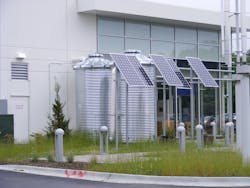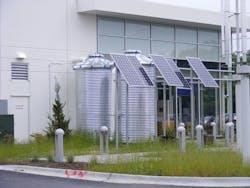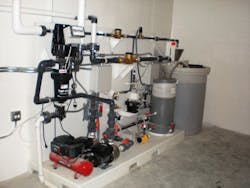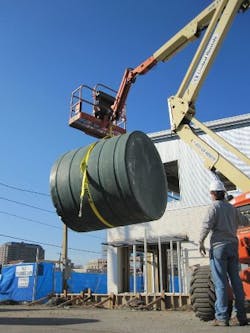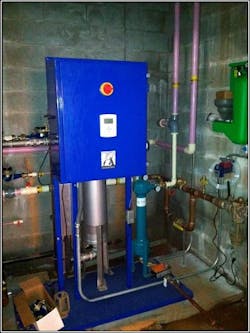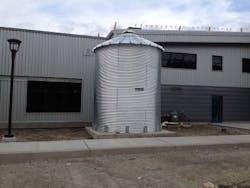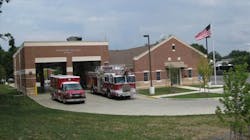A historic drought, an increase in water demand along with water shortages, and stormwater runoff, among other factors, are attributing to an increased awareness of rainwater harvesting. To some of the mechanical contracting industry, rainwater harvesting is already a known way to utilize rainwater for indoor non-potable use, and in two states — Texas and Ohio — it is utilized for indoor potable use as well. Already in place in many commercial buildings are rainwater harvesting systems, conserving the potable water supply by tapping into a free natural resource.
The Fields Volvo Dealership, Northfield, Ill., captures rooftop rainwater.
“I think those windows in which there is a crisis, such as this year’s drought, spurs people to do something,” says Billy Kniffen, vice president of the American Rainwater Catchment Systems Association (ARCSA). “This [rainwater harvesting] can turn into a huge industry. In many areas we can do rainwater capture. I have this in my home [Kniffen lives in central Texas], and it’s less than 20-in. of rainfall that we get per year and we can live off of this without a backup supply. As an industry we are getting confident that we can do this, and this confidence is spreading across the country.”
Rainwater harvesting has been around for thousands of years. According to the ARCSA’s website, www.arcsa.org, the Old Testament mentions cisterns at least 10 times, and rainwater harvesting systems in the Middle East date to 5,000 years ago. In the United States, Native Americans and early settlers relied on harvested rainwater for drinking, and in 19th century Texas, rainwater was collected and used when wells went dry or became contaminated.
A market for contractors
Fast forward to the 21st century, and there is a marketplace for all the components needed for rainwater catchment systems. Moreover, this industry creates a niche for the plumbing contractor community.
According to Kniffen, who also teaches workshops across the nation for ARCSA, he’s seeing an influx of plumbers, engineers, architects, and contractors from related industries taking courses about rainwater catchment systems. “They see this as something they can add to their portfolio as a related business.”
“There are all kinds of trades involved in these systems — architects and engineers provide the system designs, U.S. manufacturers provide the tanks, pumps, filters and other components, and then local contractors do the excavation, plumbing and electrical work necessary to install them,” says John R. Bauer, president of Water Harvesting Solutions Inc. (Wahaso), Hinsdale, Ill. “We are helping to save our valuable fresh water resources while creating a lot of jobs and labor opportunities for the trades.”
Wahaso focuses on the commercial and institutional building market and has developed large-scale rainwater harvesting systems. A recent project with Fields Volvo, located in Northfield, Ill., captures rooftop rainwater for both toilet flushing and irrigation. The project was engineered by JRB Group Architects, Arlington Heights, Ill., and consists of a 10,000-gal. Atlantis Raintank located below grade and two 4,400-gal. CorGal steel tanks, installed by Ramm Plumbing Co., Elk Grove Village, Ill. The projected annual water savings is 265,000-gal. The system was commissioned in February 2011.
The processing system skid at the Fields Volvo Dealership.
“We think the design-build approach is best for this industry,” explains Bauer. “These systems are all custom to some degree, and there are many hand-offs along the process, from scoping done with architects to system specifications done with the engineers to the fabrication of the skids to the installation by a plumbing or mechanical contractor to the commissioning with the building maintenance staff. When the scoping and specification phases are separated from the build or installation steps, there are too many opportunities for disconnects that can lead to problematic systems.” Wahaso works with local contractors to install the systems; they oversee the installation and then provide commissioning and warranty service.
A growing industry
Mike Ruck, chief water officer of Rain Water Solutions, Raleigh, N.C., recently installed the rainwater catchment system on the new, two-story 10,000-sq.ft. BuildSense Inc. headquarters, a design-build firm located in Durham, N.C. The building is on track to receive U.S. Green Building Council (USGBC) LEED Platinum Certification.
“Rainwater will be used mainly to flush commodes at 1.6-gpf, so they have plenty of water to flush toilets,” said Ruck. “They have a 3,000-gal. tank and very little will be used for irrigation. In an event there is a problem with the cistern or a drought there is a municipal backup water supply. There is also a series of water meters installed, so water usage is tracked.”
The BuildSense Inc. project stores rainwater in a 3,000-gal. tank.
Rain Water Solutions also manufactures rain barrels, and Ruck has memories of the rain barrel that started the business.
“My grandparents lived in South Texas, and in the 1950s my grandfather had a plumber make a rain barrel for my grandmother since she was an avid gardener,” recalls Ruck. “In the early ‘90s when my wife and I bought our first house, my father asked if we wanted the rain barrel, so we took it home. In 1997 we had a drought and realized how great the rain barrel was, so we decided to start making the rain barrels, using the one in the family as a model.”
The rain barrels started to be mass-produced in 2002, and in 2006 Ruck opted to leave his day job and make Rain Water Solutions a full-time career. “We got into the larger systems in 2006,” explains Ruck.” There is a lot of work in this market if you do good work. The biggest system we have is almost 140,000-gal.”
Ruck notes that the BuildSense project was tough since in North Carolina the plumbing code makes it difficult to bring rainwater inside a building, so in order to do this it needs to go through a series of treatment processes.
“We incorporated a vortex filter on the outside of building, and we needed to control the entire path the water takes to its end use,” explains Ruck. “This building has a metal roof, which is ideal for collecting rainwater. The slicker the surface the better since the less contaminants will stick to it. Then the water goes to a vortex filter, which will filter the water down to a 230-micron level, so it’s keeping out debris, pollen, etc. Then a floating extractor in the tank is used to draw out the water near the top of the tank. The water then goes into the building, into a pump, and the pump pressurizes the water that goes through a two-stage filtration process, then it goes through a UV sterilizer.”
According to Robert O'Donnell, partner of Aquanomix LLC of Davidson, N.C., rainwater harvesting offers tremendous opportunity to grow businesses in the industry. Aquanomix designs controls and treatment skids engineered to filter and disinfect harvested rainwater, graywater, foundation, storm and process for reuse as cooling tower, toilet, and irrigation makeup water. Click here to review a drawing of an Aquanomix treatment skid.
One of the company’s recent projects was for Haywood Community College’s Creative Arts Building, Clyde, N.C. Since water efficiency is an important component of any LEED program — the college’s goal is for the building to obtain USGBC LEED Platinum certification — rainwater harvesting and reuse was selected to increase sustainability across the campus and provide ROI.
The Aquanomix Water Management Center at Haywood Community College.
System components include a below-ground cistern to capture water from the rooftop drainage system for reuse in the building cooling tower or toilets; the Aquanomix Water Management Center (WMC), which harvests and manages water for cooling tower makeup, flushing toilets, irrigation, or any non-potable use in one integrated system; and pre-engineered treatment and controls skids that are designed for flow rates ranging from 20-100-GPM.
When needed by the cooling tower, the Aquanomix WMC control system energizes the submersible cistern pump, which delivers water to the WMC treatment skid where it then goes through two stages of particle filtration and disinfection by the ultraviolet disinfection unit. The Aquanomix controls platform is capable of managing stormwater flow through predictive weather modeling, utilizing smart technology to hold stormwater during precipitation and release it after the precipitation event has passed.
According to O'Donnell, in some areas of the nation, this functionality will aid future stormwater management programs by alleviating some of the Combined Sewer Overflow (CSO) burdens generated by releasing large volumes of water to combined sewer systems during heavy rain events.
A finite supply
O’Donnell also points out that water is becoming a very hot topic and people are starting to realize that it is a finite supply.
“We have to be good stewards of water,” says O’Donnell. “This offers contractors an opportunity to get engaged with the design and build out of these systems. The plumbing systems are becoming more advanced, and integration into the building management systems will be a key focus for proper management of these reclaimed water systems moving forward. Knowledgeable plumbing contractors are a pivotal part of the success of rainwater harvesting”
“One of the things you will hear is that there is no payback for rainwater harvesting,” explains Kevin Cochran, water management advisor at Aquanomix. “The drought of 2008 hit Georgia hard, and that got people’s attention on rainwater harvesting. People started thinking about reusing water for toilets, and based their decisions on money to buy these systems. At the time, the problem was no payback because the cost of water was so cheap, but things have changed in a few years — water rates have gone up around the country, every year, and the costs of these systems have come down as more uses are found for this high-quality water source.”
Cochran notes that as the industry progresses, the cost decreases, and there is a financial reason for installing these systems in many cases.
“These systems are an investment, and if you are building a new facility, don’t make the mistake and analyze this as an equipment purchase that needs a three-year payback,” says Cochran. “It may take longer to pay off this system, but after it’s paid off, it will be a smart investment because no one knows how much water will cost 10 years from now.”
Many drivers
Of course rainwater harvesting is good for the environment; however, there are many different factors besides sustainability driving rainwater harvesting. The drought and water rate increases are two that come to mind.
“Water rate increases are pushing double digits in some areas, and in some instances it’s 20% to 25% a year,” says Cochran. “I’m seeing this across the U.S. as I travel, so this is not only a water conservation technology, but a prudent bottom-line decision. Other factors driving rainwater harvesting are combined sewer systems (there is a real opportunity to help with that in major metropolitan areas). There are now consent decree orders from the Environmental Protection Agency telling cities they have to control stormwater that flows to water supplies, so rainwater harvesting will be a huge driver moving forward. Plus, we have the same amount of water on earth as we did during ancient Roman times, but the population has just eclipsed more than 7 billion people on earth and that is projected to hit 10 billion people by 2050.”
RainBank, an ARCSA accredited designer/installer of rainwater collection and storage systems, located in Arlington, Wash., has installed and packaged systems from 2,500-gal. up to 50,000-gal.
“State, local, and federal governments could and should offer incentives for rainwater collection as much as they do for solar,” says Ken Blair, principal of RainBank. “For every 1,000-sq.ft. of roof by 1-in. of rainfall, 623-gal. can be collected. This can add up to a lot of stored water even with the smallest amount of rainfall; mist and snow can also be considered as part of a collection plan. The other side of the equation is balancing the ‘use’ to the available resource and that's where the conservation focus comes into play.”
The Puget Sound Energy building.
In the Puget Sound region of Washington where the Puget Sound Energy building is located — one of RainBank Rainwater Catchment Systems’ projects — stormwater runoff is a contributing factor in pollution of the region, thus, to control the stormwater runoff, one 11,700-gal. tank stores the rainwater that is used for toilet flushing.
“State and local agencies mandated that stormwater runoff is to be controlled,” said Blair. “Collecting rainwater from the roof, storing it, filtering it, and using it for needs such as toilet flushing, hand washing, irrigation, or wash down like at the Puget Sound Energy building not only reduces the amount of municipal water use, but also reduces stormwater runoff,” says Blair.
The Williamson Road Fire Station in Roanoke, Va., is another project managing stormwater runoff. Designed and installed by Rainwater Management Solutions, Salem, Va., the rainwater collected is used to flush toilets and wash fire trucks.
The Williamson Road Fire Station.
After the rainwater is harvested off of the 9,000-sq.ft. roof, it is diverted through two self-cleaning vortex filters. Water is then stored in a 10,000-gal. below-ground fiberglass tank. Other rainwater components include two smoothing inlets, two coarse floating filters, and UV light purification system. The installed filters ensure the tank will never require cleaning and no products will require replacement.
The concept of rainwater harvesting has been around for centuries, and BRAE, Oakboro, N.C. was created out of a desire to make rainwater harvesting technologies available to customers in North America. BRAE delivers end-to-end rainwater harvesting solutions for commercial and residential projects with a combined 75 years of experience in the water filtration, storage, distribution, and treatment industries.
One of the company’s recent projects is the Northern Guilford High and Middle Schools located in Greensboro, N.C. Harvested rainwater is used for toilet flushing and fire suppression. The rainwater is used to flush toilets in both schools and the bottom half of the cistern is reserved for the fire protection system. The schools have a centralized rainwater system and both buildings share a common cistern. Rainwater from the schools’ roofs flows to a 360,000-gal. cast-in-place concrete tank and will conserve approximately four to five million gallons annually.
Click here to read Candace Roulo's blog about rainwater harvesting.
About the Author
Candace Roulo
Candace Roulo, senior editor of CONTRACTOR and graduate of Michigan State University’s College of Communication Arts & Sciences, has 15 years of industry experience in the media and construction industries. She covers a variety of mechanical contracting topics, from sustainable construction practices and policy issues affecting contractors to continuing education for industry professionals and the best business practices that contractors can implement to run successful businesses.
